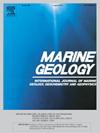作为陆源有机碳汇的白令海陆架:来自沉积物地球化学的见解
IF 2.2
3区 地球科学
Q2 GEOSCIENCES, MULTIDISCIPLINARY
引用次数: 0
摘要
最近的北极变暖加速了永久冻土的融化,将古代有机碳(OC)转移到海洋中。与育空河和阿纳德尔河等主要河流相连的白令海接收了大量的陆地碳输入。然而,陆源OC的来源和命运仍然不清楚。本文通过分析白令海陆架表层沉积物TOC、TN、δ13C、木质素酚类、粒径、SSA等参数,探讨了白令海陆架表层有机质的来源和汇。OC和TN表现出相似的空间格局,西部地区浓度较高,而沿阿拉斯加海岸流(ACC)浓度较低。δ13C值自东向西递减,在- 24.36‰~ - 22.03‰之间,表明陆源OC的影响向西减弱,C/N比值也证实了这一点。木质素含量(Λ8)在0.49 ~ 4.58 mg/100 mg OC之间变化,在育空河河口附近达到峰值。丁香基与香草基酚(S/V)和肉桂基与香草基酚(C/V)的比值表明被子植物和裸子植物的混合输入。研究结果表明,陆源OC的分布主要受水动力分选和矿物表面吸附的控制。我们的结论是,白令海陆架作为陆源有机碳的净汇,这一现象预计将随着预期的北极变暖而加剧。本文章由计算机程序翻译,如有差异,请以英文原文为准。
The Bering Sea shelf as a sink for terrigenous organic carbon: Insights from sediment geochemistry
Recent Arctic warming has accelerated permafrost thaw, mobilizing ancient organic carbon (OC) into the ocean. The Bering Sea, connected to major rivers such as the Yukon and Anadyr, receives substantial terrigenous carbon inputs. However, the sources and fate of the terrigenous OC remain poorly characterized. In this study, we aimed to assess the sources and sinks of organic matter on the Bering Sea Shelf by analyzing multi parameters such as TOC, TN, δ13C, lignin phenols, grain size and SSA of the surface sediments. OC and TN exhibit similar spatial patterns, with higher concentrations in the western region but lower along the Alaska Coastal Current (ACC). δ13C values decreased from east to west, ranging from −24.36 ‰ to −22.03 ‰, suggesting a westward decline in terrigenous OC influence, corroborated by C/N ratios. Lignin content (Λ8) varies from 0.49 to 4.58 mg/100 mg OC, peaking near the Yukon River estuary. Ratios of syringyl to vanillyl (S/V) and cinnamyl to vanillyl (C/V) phenols indicate mixed inputs from angiosperms and gymnosperms. Our findings demonstrate that the distribution of terrigenous OC is primarily governed by hydrodynamic sorting and mineral surface adsorption. We conclude that the Bering Sea shelf functions as a net sink for terrigenous organic carbon, a phenomenon expected to intensify with anticipated Arctic warming.
求助全文
通过发布文献求助,成功后即可免费获取论文全文。
去求助
来源期刊

Marine Geology
地学-地球科学综合
CiteScore
6.10
自引率
6.90%
发文量
175
审稿时长
21.9 weeks
期刊介绍:
Marine Geology is the premier international journal on marine geological processes in the broadest sense. We seek papers that are comprehensive, interdisciplinary and synthetic that will be lasting contributions to the field. Although most papers are based on regional studies, they must demonstrate new findings of international significance. We accept papers on subjects as diverse as seafloor hydrothermal systems, beach dynamics, early diagenesis, microbiological studies in sediments, palaeoclimate studies and geophysical studies of the seabed. We encourage papers that address emerging new fields, for example the influence of anthropogenic processes on coastal/marine geology and coastal/marine geoarchaeology. We insist that the papers are concerned with the marine realm and that they deal with geology: with rocks, sediments, and physical and chemical processes affecting them. Papers should address scientific hypotheses: highly descriptive data compilations or papers that deal only with marine management and risk assessment should be submitted to other journals. Papers on laboratory or modelling studies must demonstrate direct relevance to marine processes or deposits. The primary criteria for acceptance of papers is that the science is of high quality, novel, significant, and of broad international interest.
 求助内容:
求助内容: 应助结果提醒方式:
应助结果提醒方式:


